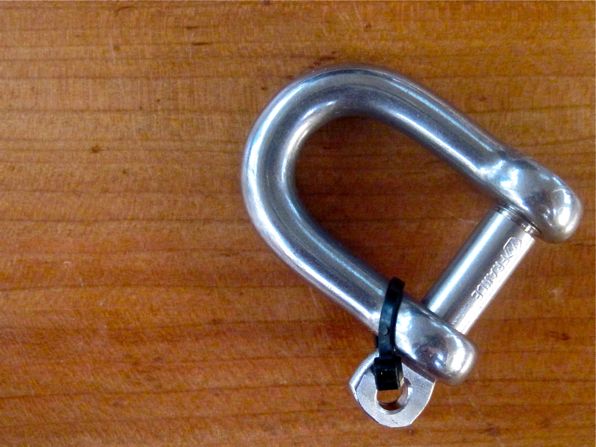When having a mouse on a boat is a good thing.
Look around on any boat larger than a canoe and you’ll likely find shackles. The bigger the boat, the larger they will be and the more you’re likely to find. From wikipedia:
A shackle, also known as a gyve, is a U-shaped piece of metal secured with a clevis pin or bolt across the opening, or a hinged metal loop secured with a quick-release locking pin mechanism. They are used as a connecting link in all manner of rigging systems, from boats and ships to industrial crane rigging.
Want to make sure the clevis pin stays in the shackle? Then mouse it closed. Mousing, pronounced mouzing* according to wikipedia is “the application of safety wire, called mousing wire in this use, to secure a threaded clevis pin to a shackle. This is done by passing a couple of turns of mousing wire through the hole provided for this purpose in the unthreaded end of the clevis pin and around the body of the shackle’s hoop.”
They also go on to say that you can use zip ties instead of wire to mouse a shackle closed, which is what we actually use on ZTC (we use black zip ties as they are reportedly more UV resistant).

A shackle properly moused shut.
Why bring this up today? Because there was only one shackle on our entire boat that was not moused closed. Guess where it is now? At the bottom of Hermitage Bay. 🙁
On our anchor bridle, there are two shackles which connect the chain plate to the bridle lines. One never gets opened so it is moused closed. The other is removed each time we raise anchor. Because that one goes on and off so frequently, we don’t mouse it closed, our thought being that the vibration or movement that would be required to unscrew the clevis pin couldn’t possibly happen in the short period of time that our boat would be stationary. And we have been right about that, until now!

One of those two large shackles was recently sacrificed to Poseidon.
During Rebecca’s workout on the bow yesterday morning, she happened to look down at the bridle and see that it was hanging strangely. When she pulled it in to inspect it, she could see what had happened. The unsecured shackle had somehow come unscrewed and had fallen off. Fortunately we had planned ahead and purchased a replacement for it, as it’s a particularly large one, a bit uncommon on a boat this size. But now that our spare is in use, we’ll have to try to purchase another one to take its place in the rigging kit. And we’ll also need to make sure that we check that thing every few days as we stay at anchor because we sure don’t want that happening again.
Do you have any shackles on your boat that are not moused closed? If you want them to stay that way, closed, you might consider mousing them closed. Yes, learn from our mistakes… it’s less painful that way.
*Up until today, when I looked it up to write this blog post, I always pronounced “mousing” as the act of hunting for tiny rodents. 🙂




A short length of stainless or monel wire that you can use just like a twisty tie. Couple of twists would be better than no twists. Easy to remove in a hurry if needed.
I do understand that Ken, it’s just not super convenient to apply that on a shackle we remove every other day or so, while perched on the bow of our boat. But, it may come to that. Strangely we have used the same system for 5000+ miles, anchoring nearly 500 times, without it coming undone.
Maybe attach one end of the tie permanent to the shank (couple clove hitches) so
there is a long end just to loop into the pin eye.
Good idea.
We use almost the same system that you have pictured above only without the second plate behind that has to be removed each time you anchor. We always put a big loop of chain between the boat and the bridle which holds the “seadog” in place, in addition to lowering the angle of pull. We never take those shackles off unless we are hooking to a mooring ball. Is your system just for additional security. Ours has never failed us.
Hi Pat
We had a friend make up the bar that fits across the top of the plate because we were having difficulty deploying the bridle without the chain slipping off. Once it was out, with the lazy loop of chain that you describe, it was no problem. It was getting it out there, especially single handed, that was the problem. The extra plate solves that issue but as you can see, adds another element to the process.
Your bridle plate seems to be the method that is becoming the most popular.
An easy way to retain the shackle pin is to tie a thin piece of strong string to it, and onto the side of the shackle itself. You want about six inches spare I find. Then just put the pin in and turn it tight enough. If you drop the pin while trying to fix it, or if it shakes free, it is still captive. Modern synthetic light twine/cord lasts years without deteriorating appreciably.
Mike
Hi Mike
Yes, a cord like that might just work perfectly. Thanks for the suggestion.
I like Mr. Bruce’s suggestion. Also, you can get releasable ty-raps that have a little tab on them that you depress with your thumb to allow you to remove the ty-rap. I don’t think they are available in black. Around $50 for 100 or $160 for 1000. go to http://www.panduit.com/Products/ProductOverviews/CableTies/index.htm and type “releasable” into the search field.
Thanks Lyndsay. Will look into that.
Yeah well… shackel schmackel. At least you’re not starting your dinghy (car) 15 mins before you leave and scraping ice of the windows anymore!
Have ya’ll given any thought to a circumnavigation of the Gulf? Coming up around TX, LA, MS, AL and FL? And being Canadian, can’t you actually visit Cuba?
Hi Cameron
The only ice I want to see is in my glass!
One plan we have discussed is heading up the central american coast to Cuba. We’ll see what happens.
Since I am to some extent responsible for this renewed interest in bridle plates on catamarans, or at least for improving and reintroducing the idea…
http://sail-delmarva.blogspot.com/2009/03/ultimate-chain-hook-for-catmarans.html
… I’m going to add my 10 cents worth, certainly applicable to A PDQ 32. I fabricated this plate 2 1/2 years ago and if I replace it, it will be the same, but in stainless. It does every thing I want.
Have a machinist enlarge one of the holes (I used 5/8-inch, but less would do) to take a carabiner rated at near the MWL of your chain (1/4-inch G4 is 2600 pounds MWL). It need not be full strength, as there are 2 legs. It will NEVER unclip in this application, so it need not be a locking biner. Use this biner, just for peace of mind, on the chain side, so that if it did fail, you would only slip back a short distance, backed up by the chain.
Do NOT simply have him drill it; it looks to me like there wouldn’t be enough metal left on the outboard side. For strength reasons, you need 1/4-inch all around. A die grinder should do the trick. A 1/2-inch hole should be enough, but get the biner in hand first. I’d be comfortable with a climbing biner (MWL 1830 pounds), though I use a SS biner (no idea what model).
This is what I have done for several years–clipping in takes only seconds and you will never loose a shackle. All things considered (it can’t unscrew) I think it is safer. If a hurricane is coming, you can always substitute a shackle, but I wouldn’t.
And yes the plates can come off without the lock IF they lie on the bottom. Many, including me, have reported this. It’s not common, but it’s possible.
After reading that you used a biner, I once spent some time looking for one that would fit, unsuccessfully. Is yours a [gasp!} marine one, or is it a climbing biner?
It’s a “marine” biner. I doubt it’s any stronger–I’m certain it’s not–but I didn’t want the aluminum wearing on the steel and I had the SS biner. The PO used it as an anchor shackle, which is not as good an idea; it is quite possible for a biner clipped to an anchor shank to get rotated and unclip.
Yeah, the hole on your plate is too small.
And climbers NEVER use steel biners. Typically we climb with about 40 biners plus other gear on the rack; such a rack would weigh 30 pounds!
Thanks for the clarification, Drew.
Sorry for replying to an old post (as I’m really trying to catch up with you in present time), but this post rekindled a funny story for me. I had a dinghy attached with an unmoused shackle and one morning woke up to find her gone. I hailed harbor patrol and it turned out another cruiser had seen the unmanned tender “ghosting” through the harbor early that morning in Salem, Massachussets and had turned it over to them. Harbor was even so kind to even tow it back to my vessel. This only proves the quality of people, both cruisers and officials, that you’ll find on the water. The real lesson in this story is to do what you have done: mouse every shackle you can find on board! Hope to be able to do what the both of you are doing one day.